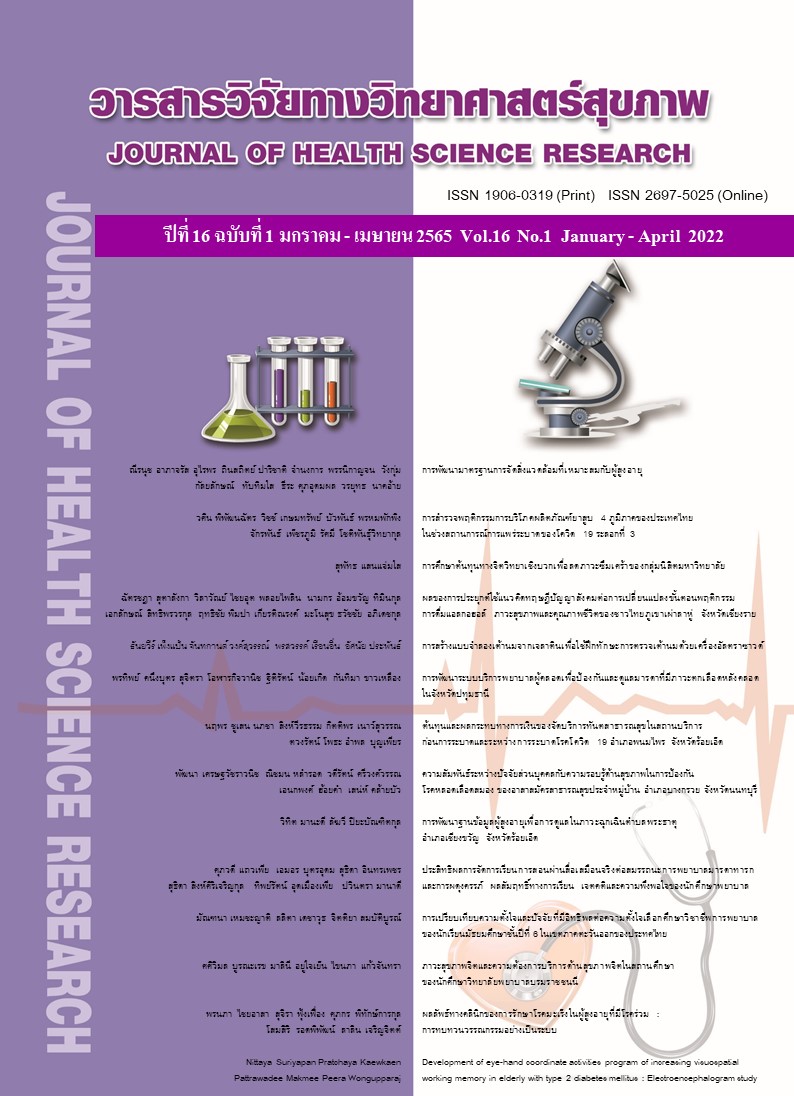การพัฒนาระบบบริการพยาบาลผู้คลอดเพื่อป้องกันและดูแลมารดา ที่มีภาวะตกเลือดหลังคลอดในจังหวัดปทุมธานี
Main Article Content
บทคัดย่อ
บทนำ : การตกเลือดหลังคลอดเป็นภาวะแทรกซ้อนที่พบบ่อยและเป็นสาเหตุการตายมารดาทั่วโลก
วัตถุประสงค์การวิจัย : เพื่อพัฒนาระบบบริการพยาบาลผู้คลอดในการป้องกันและดูแลมารดาที่มีภาวะตกเลือดหลังคลอด
วิธีการวิจัย : การวิจัยและพัฒนา มี 3 ระยะ ดังนี้ 1) วิเคราะห์สถานการณ์ 2) พัฒนาระบบบริการพยาบาลผู้คลอด และ 3) ประเมินผลลัพธ์ ตัวอย่างเลือกเจาะจง ได้แก่ ผู้ให้บริการ 65 คน ผู้รับบริการ 1,221 คน เครื่องมือการวิจัย 1) แนวทางประเมินความเสี่ยงและการพยาบาลเพื่อป้องกันการตกเลือด 2) แนวทางดูแลผู้คลอดที่มีภาวะตกเลือด 3) แนวทางการส่งต่อผู้คลอดที่มีภาวะวิกฤต และ 4) แนวทางการนิเทศทางคลินิก เครื่องมือเก็บข้อมูล ได้แก่ 1) แบบทดสอบความรู้ 2) แบบประเมินทักษะ 3) แบบสังเกตทักษะ 4) แบบสอบถามความพึงพอใจต่อการนิเทศ และ 5) แบบสอบถามความพึงพอใจต่อการพัฒนา วิเคราะห์ข้อมูล ใช้สถิติเชิงพรรณนา ทดสอบค่าที และวิเคราะห์เชิงเนื้อหา
ผลการวิจัย : ผลลัพธ์การพัฒนาระบบ พบว่า ผู้ให้บริการ มีความรู้เพิ่มขึ้นอย่างมีนัยสำคัญทางสถิติ (p<.01) ทักษะเพิ่มขึ้นมากที่สุด ปฏิบัติตามได้ ร้อยละ 83.33 และมีความพึงพอใจต่อการนิเทศระดับสูง (M=3.81, SD=0.32) ผู้รับบริการ มีความพึงพอใจมากที่สุด (M=4.80, SD=0.43) คุณภาพบริการพยาบาล พบว่า ลดอัตราตกเลือด ลดการเกิดภาวะช็อกจากตกเลือด และอัตราการตัดมดลูกลดลง
สรุปผล : การดูแลผู้คลอดเพื่อป้องกันภาวะตกเลือด โดยมีแนวปฏิบัติการพยาบาลและการนิเทศทางคลินิกที่ชัดเจน ทำให้ผู้ปฏิบัติเกิดความมั่นใจในการดูแลผู้คลอดมากขึ้น ลดการเกิดภาวะแทรกซ้อนได้
Downloads
Article Details

อนุญาตภายใต้เงื่อนไข Creative Commons Attribution-NonCommercial-NoDerivatives 4.0 International License.
บทความที่ได้รับการตีพิมพ์เป็นลิขสิทธิ์ของวิทยาลัยพยาบาลบรมราชชนนี จังหวัดนนทบุรี
ข้อความที่ปรากฏในบทความแต่ละเรื่องในวารสารวิชาการเล่มนี้เป็นความคิดเห็นส่วนตัวของผู้เขียนแต่ละท่านไม่เกี่ยวข้องกับวิทยาลัยพยาบาลบรมราชชนนี จังหวัดนนทบุรี และคณาจารย์ท่านอื่น ในวิทยาลัยฯ แต่อย่างใด ความรับผิดชอบองค์ประกอบทั้งหมดของบทความแต่ละเรื่องเป็นของผู้เขียนแต่ละท่าน หากมีความผิดพลาดใด ๆ ผู้เขียนแต่ละท่านจะรับผิดชอบบทความของตนเองแต่ผู้เดียว
เอกสารอ้างอิง
The Royal Thai College of Obstetricians and Gynaecolodists. RTCOG Clinical Practice Guidelines . 2nd ed. Bangkok; 2015. (in Thai).
Corwin EJ, Murray-kolb LE, Beard JL. Low hemoglobin level is a risk factor for postpartum depression. J Nutr. 2003;133 (12):4139-42. doi: 10.1093/jn/133.12.4139.
WHO, UNICEF, UNFPA, World Bank Group, United Nations population division. trends in maternal mortality: 2000 to 2017. Geneva: World Health Organization. [internet]. 2019 [cited 2022 Mar 10]; Available from: https://data. worldbank.org/indicator/SH.STA.MMRT?locations=TH.
Department of Health. Ministry of Public Health. Analysis of the mother die situation in 2019. [internet]. 2019 [cited 2020 Jan 9]; Available from: https://hp.anamai.moph.go. th/th/maternal-mortality-ratio/download?id= 73426&mid=30954&mkey=m_document&lang=th&did=24017. (in Thai).
Say L, Chou D, Gemmill A, Tunçalp Ö, Moller AB, Daniels J, et al. Global causes of maternal death: a WHO systematic analysis. Lancet Glob Health. 2014;2(6):323-33. doi. 10.1016/S2214-109X (14)70227-X.
Benedetti TJ. Obstetric Hemorrhage. In: Gabbe SG, Niebyi JR, Simpson JL, eds. Obstetrics. Normal and problem pregnancies. 4th ed. New York: Churchill Livingstone; 2002.
Pathumthani Public Health Office. Birth Report 2015-2019 in Pathumthani. Pathumthani; 2020. (Unpublished). (in Thai).
Proctor B. Training for the supervision alliance: attitude, skills and intention. in Cutcliffe JR, Fowler J, Hyrkas K (eds). Routledge handbook of clinical supervision: fundamention international themes. Routledge; 2010.
Limtrakul D. Developing a nursing supervision model of anesthetist nurse division for standardize and quality of service. Hua Hin Sook Jai Klai Kangwon Journal. 2019;4(1):1-14. (in Thai).
Tohkani D, Siriphan S. Skill of maternal & newborn nursing and midwifery. 4thed. Bangkok: Vithayapat; 2016. (in Thai).
Tantisuk W. The development of participatory clinical supervision pattern of registered nurses at the private hospital in Bangkok. [Dissertation]. Bangkok: Christian University of Thailand; 2013. (in Thai).
Eiumargaht D. Effect of the use of clinical nursing supervision of head nurse that integrated collaboration concepts on perceived nursing outcome as reported by professional nurses. [Dissertation]. Bangkok: Saint Louis College; 2010. (in Thai).


